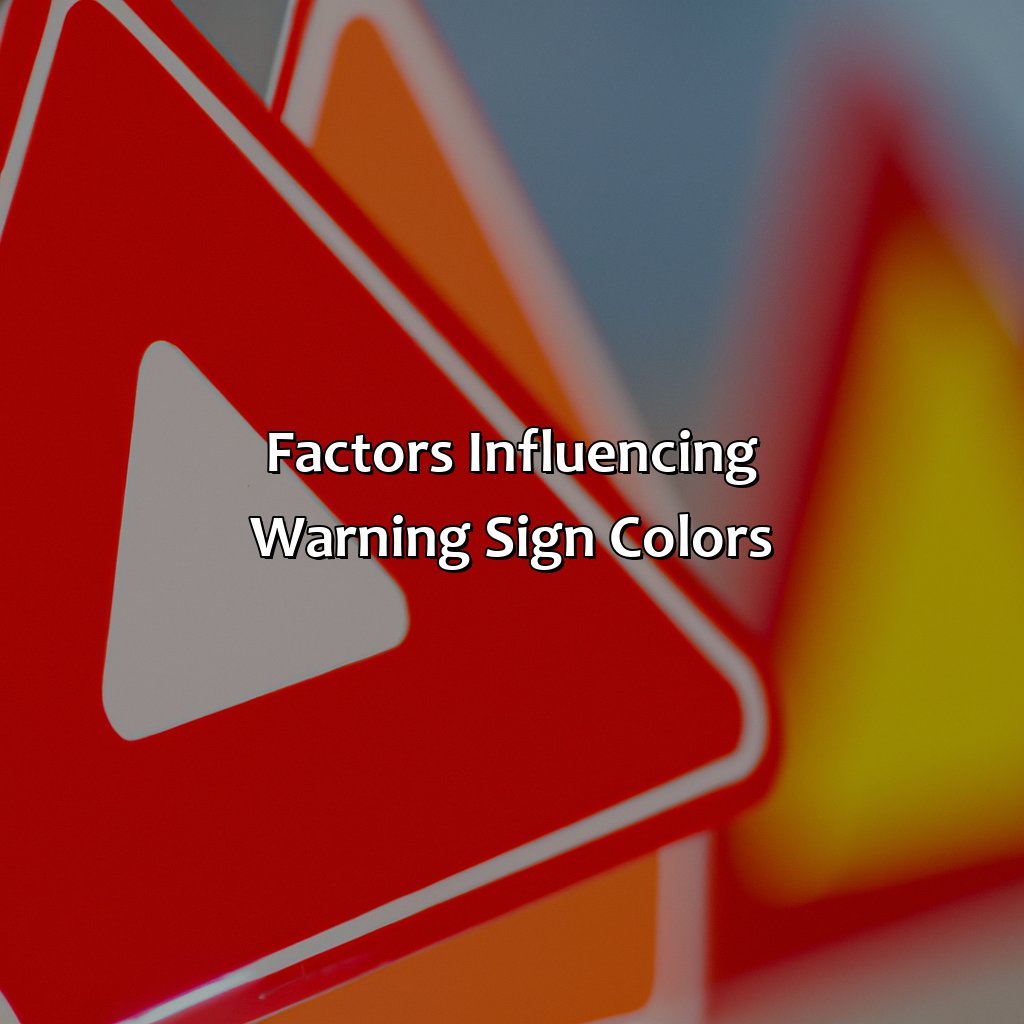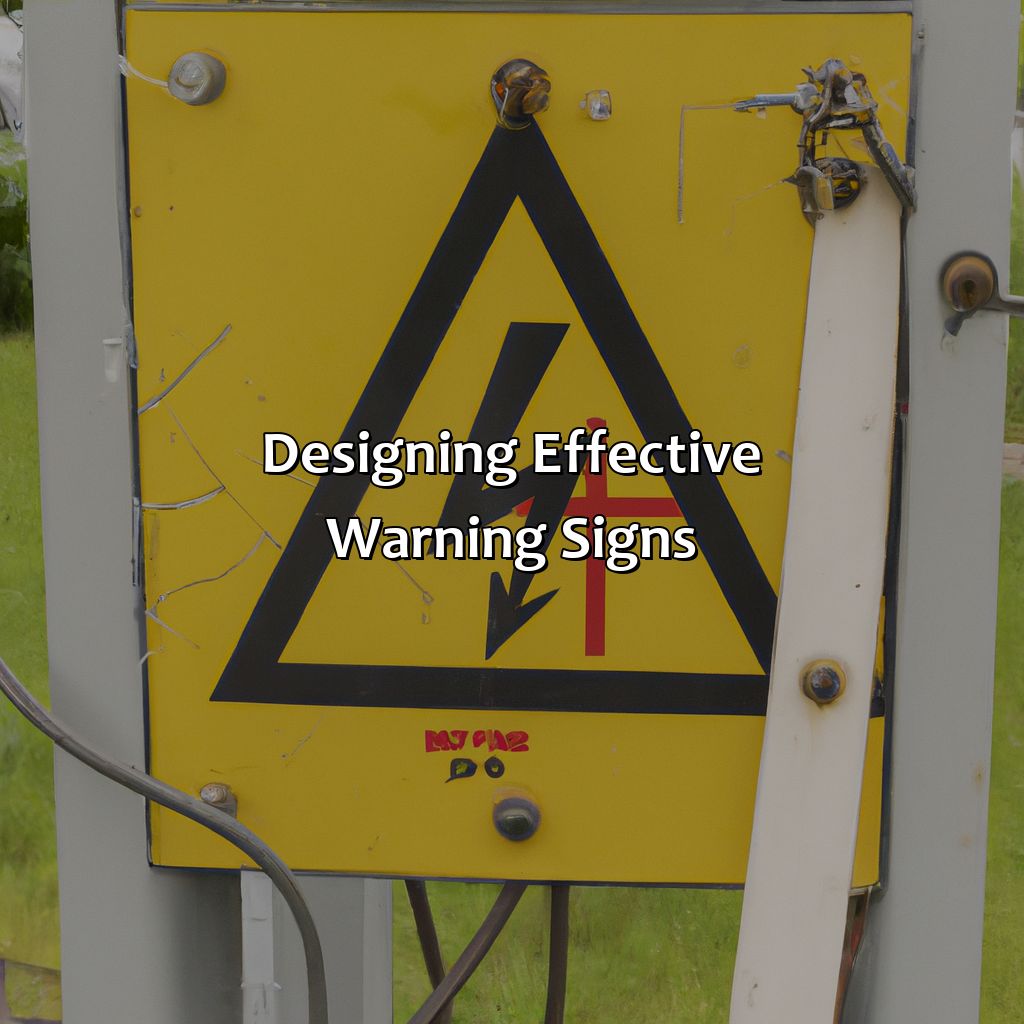Key Takeaway:
- Warning signs are typically red, yellow, or orange: These colors are commonly used to indicate danger, warning, and caution, respectively. Blue and green are less commonly used, but may be used to indicate informational or instructional signs.
- The standardization of warning sign colors is important: Following an international convention for warning sign colors ensures that people can understand and react appropriately to warning signs, regardless of their language or location.
- Factors such as risk, visibility, and cultural and psychological associations can influence warning sign color choices: Designers should carefully consider these factors when selecting warning sign colors to ensure that they effectively communicate the intended message and elicit the desired response from viewers.
Standardization of Warning Sign Colors

Photo Credits: colorscombo.com by Terry Torres
Warning signs play a crucial role in preventing accidents and injuries. As a result, standardization of warning sign colors has gained importance. The international convention has recognized the need for uniformity in the use of colors for warning signs to prevent confusion.
To understand the standardization of warning sign colors, let’s take a look at the following table:
| Warning Sign Color | Meaning |
|---|---|
| Red | Indicates an immediate danger |
| Yellow | Indicates a potential hazard |
| Orange | Used for warning signs in construction sites |
| Green | Indicates safety equipment and first aid |
As we can see from the table, warning signs require proper color-coding to convey the message effectively. Standardization ensures that each color has a clear and universally understood meaning, removing confusion due to regional variations.
It is essential to note that while standardization exists, there may be slight variations in color shades due to differences in local regulations. However, such differences are minimal and do not affect the overall efficacy of the warning sign.
Therefore, organizations must adhere to the standardization of warning sign colors to maintain consistency and ensure the safety of all individuals who interact with the warning signs. In doing so, the risk of accidents and injuries can be minimized, which can save lives and prevent significant losses.
Examples of Warning Sign Colors

Photo Credits: colorscombo.com by Edward Torres
Warning signs are an essential tool for preventing accidents and ensuring safety in public and private spaces. These warning signs come in various colors, each with a unique meaning and purpose. Understanding warning sign colors is crucial in creating a safe environment for everyone.
Below is a table showcasing examples of warning sign colors and their meanings:
| Color | Meaning |
|---|---|
| Red | Indicates immediate danger or prohibition |
| Yellow | Warns of potential hazards or caution |
| Orange | Indicates a warning or alert |
| Blue | Informs of mandatory actions or information |
| Green | Indicates safety or direction |
It is important to note that some warning signs may have multiple colors to convey their message more effectively. Furthermore, it is crucial to follow the instructions mentioned on these signs and act accordingly. With that being said, understanding the different colors of warning signs is an essential step towards ensuring safety in any environment.
It is also worth mentioning that colors have been used to convey warning messages for centuries. The ancient Greeks and Romans used red flags to signal danger, while green flags represented safety. This idea was later adopted by maritime industries, where red and green lights were used to differentiate between the port and starboard of a ship. The concept of using colors for warning and safety signs has evolved and become standardized over time. Today, different industries, including transportation, construction, and healthcare, all use specific colors to convey warning messages effectively.
Factors Influencing Warning Sign Colors

Photo Credits: colorscombo.com by Joseph Hernandez
Factors that impact the colors of warning signs are varied and complex. Understanding the psychological and cultural associations of colors is crucial when designing cautionary messages. In addition, factors like visibility, contrast, and risk assessment are also important considerations.
The following table shows the impact of different factors on warning sign colors:
| Factors | Impact |
|---|---|
| Cultural associations | Specific hues may evoke different meanings in different cultures |
| Psychological associations | Certain colors can trigger emotional responses or associations |
| Visibility | High-contrast colors improve visibility and catch attention |
| Contrast | Contrasting colors help convey urgency and importance |
| Risk assessment | The level of risk being communicated may influence the color choice |
It is crucial to note that the impact of each of these factors varies depending on the context and intended message. Designers need to consider these factors carefully to ensure that the warning sign colors convey their intended meaning effectively.
Unique details to consider when designing warning sign colors include the fact that some colors, such as red and yellow, are widely associated with danger and caution. Additionally, cultural differences in color associations should be taken into consideration, as certain hues may hold negative or positive connotations in certain regions.
A true story that highlights the importance of choosing the right warning sign color involves a manufacturer who used green and yellow on equipment that required caution. This led to confusion and accidents on the job site, as these colors are often associated with safety and not caution. The manufacturer had to quickly revise their color scheme to include red and orange to effectively communicate the required message.
Designing Effective Warning Signs

Photo Credits: colorscombo.com by Benjamin Rivera
Warning signs are crucial in providing individuals with possible danger notification. To design effective warning signs, designers should be deliberate about the symbols used, text displayed, placement, size, and color combinations. The selection of colors is particularly important as people associate certain colors with danger, such as red or orange. Additionally, designers should consider the audience when selecting colors for warning signs. For instance, red may not be the best choice for individuals who are colorblind.
In designing warning signs, effective visual communication is key. By using symbols and text, designers can ensure that the message is conveyed clearly to the intended audience. Symbols should be easily identifiable and easy to memorize, while text should be brief and to the point. Additionally, designers should consider the placement of the warning sign. It should be positioned in a way that ensures it is easily spotted, and individuals have enough time to take appropriate action.
One unique detail to consider is the use of color combinations to create maximum impact. Designers can use contrasting colors to create a high level of visual contrast, which grabs attention and draws the eye to the warning message. For example, using black text on a yellow background creates a high level of contrast, making the sign stand out more.
A true story that highlights the importance of effective warning sign design involves a hospital where staff members were struggling to prevent patients from slipping on wet floors. Despite warning signs being in place, staff members found that patients continued to fall. The hospital administration realized that the sign’s red color was not ideal, and it was changed to a yellow sign with bold black text. The change helped reduce falls, and staff members found that the new warning sign was more visible and effective.
In summary, effective warning signs are designed using deliberate symbols, concise text, proper placement, appropriate size, and carefully selected color combinations. Designers should consider the audience, paying attention to different perception conditions, such as colorblindness. By following these guidelines, designers can create warning signs that are easily identifiable, memorable, and effective.
Some Facts About Warning Signs:
- ✅ Warning signs are typically yellow and black in color. (Source: OSHA)
- ✅ The color combination of yellow and black provides high visibility and attracts attention. (Source: Bright Hub Engineering)
- ✅ Warning signs are used to convey a message of potential hazard or danger. (Source: SafetySign.com)
- ✅ Warning signs are commonly seen in construction sites, roadways, and industrial facilities. (Source: Seton)
- ✅ Warning signs should be placed in areas where they can be easily seen and read by individuals in the vicinity. (Source: MySafetySign)
FAQs about Warning Signs Are What Color
What color are warning signs?
Warning signs are typically yellow with black text and icons. This color scheme provides a high level of visibility and is easy for drivers and pedestrians to recognize.
Are there any exceptions to the yellow and black color scheme for warning signs?
Yes, there are a few exceptions. Some warning signs that are related to construction or maintenance may be orange or fluorescent green to grab attention in work zones. In addition, some signs related to school zones may have a fluorescent yellow-green color.
Why are warning signs usually yellow and black?
The yellow and black color scheme was chosen because it provides high visibility even in low-light conditions. The contrast between the two colors makes the sign easy to read, and the yellow background stands out against most natural and man-made backgrounds.
Can warning signs be a different color in different countries?
Yes, warning signs can be a different color in different countries. However, most countries follow the yellow and black color scheme. Any variations would be minor and may be related to specific cultural or legal requirements.
What should I do if I see a warning sign while driving?
If you see a warning sign while driving, you should immediately slow down and take caution. The sign is there to alert you of a potential danger or hazard on the road ahead. Make sure to follow any additional instructions on the sign, such as reducing speed or stopping altogether.
What types of warning signs are there?
There are many types of warning signs, including those related to:
– Road conditions (such as slippery when wet)
– Animal crossings
– Pedestrian crossings
– Work zones
– School zones
– Construction zones
– Traffic signals
– Railroad crossings
– Lane changes
– Sharp curves
– Steep hills
– Narrow bridges
– Low clearance






